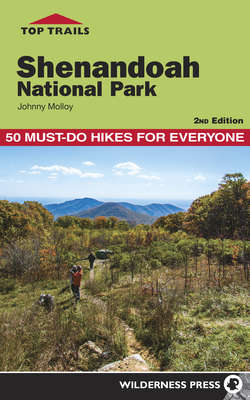Читать книгу Top Trails: Shenandoah National Park - Johnny Molloy - Страница 17
Fauna
ОглавлениеThe Shenandoah’s rich flora and large wildlands support an impressive array of mammals—more than 50 species. The black bear roams throughout Shenandoah and is commonly encountered. From the rich acorn crops of the oak forests to the fruit trees from pioneer homesteads to berries growing rampant in former fields, bears have a wide variety of food sources within the park. Don’t be surprised if you come across a bruin.
SAFETY
Bear Safety Guidelines
• Don’t leave your pack unattended on the trail.
• Keep all food, trash, or scented items in a bearproof canister or safely hung from a tree.
• Pack out all trash.
• Don’t let bears approach your food—make noise, wave your arms, throw rocks. Be bold, but keep a safe distance and use good judgment.
• Never approach a bear, especially a cub.
• Report any bear encounters to the appropriate authority.
There is no doubt that you will see white-tailed deer. When the park was populated by pioneers, unregulated hunting nearly drove the deer from Shenandoah, but today they are found along Skyline Drive and beyond. Drivers must constantly look out for these gentle creatures. They can also be found in the woods and especially in historically cleared areas such as Big Meadows.
A quiet hiker may also witness turkeys on wooded hillsides or in clearings. Furtive bobcats can sometimes be spotted crossing trails. Raccoons are occasionally seen in the wild. Coyotes, found throughout the park, will usually spot you before you see them. A bounding tan tail disappearing into the distance will likely comprise a sighting of this critter, which effectively replaced the extirpated red wolf in the East.
Extensive efforts have been made to keep all animals wild in Shenandoah. Long gone are the days of roadside feedings. Education, along with bearproof garbage cans and storage containers, has reduced negative interactions between people and wildlife.
More than 200 bird species either live in the park or migrate through it. These avians, including pileated woodpeckers and red-tailed hawks, ply the forest for food. The Eastern screech owl emits a goose bump–raising call. Songbirds native to the north and south find a home in the park, and Shenandoah’s north–south orientation adds to its importance as a migratory-bird corridor. Birding, a popular pastime in the park, can enhance any hike.
The park’s waters harbor about three dozen types of fish. Most famously, Shenandoah is a bastion for brook trout. Unlike the Smokies, this park has never had rainbow or brook trout intentionally introduced into its waters. “Brookies” are the only trout native to Shenandoah. Technically, the brook is not a true trout, but a char. Brooks prefer cold, clear waters and are found in more than 50 of the park’s 90 streams. Brown trout have been making their way into the lower reaches of Shenandoah’s streams, but biologists are trying to limit their numbers.
Rattlesnakes may be encountered on the trail—especially in sunny, rocky areas.
Spend some time hiking at Shenandoah, and you may be surprised by the variety of snakes in the area: 18 species in all. Most of those you encounter will be nonvenomous, but be aware that two kinds of poisonous snakes—the copperhead and the timber rattler—call the park home. Copperheads can be found near streams and on outcrops, whereas rattlers will primarily be seen sunning on rocks.
Shenandoah also harbors 14 types of salamanders, including the rare Shenandoah salamander, found only within the park. It’s just one more example of how the life in these mountains lives up to its national park status.
